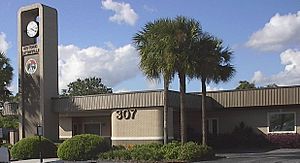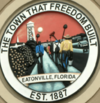Eatonville, Florida facts for kids
Quick facts for kids
Eatonville, Florida
|
||
|---|---|---|
| Town of Eatonville | ||

Eatonville Town Hall
|
||
|
||
| Motto(s):
"The Town that Freedom Built"
|
||

Location in Orange County and the state of Florida
|
||
| Country | ||
| State | ||
| County | Orange | |
| Founded (Lawrence) | c. 1880-1881 | |
| Incorporated (Town of Eatonville) |
August 15, 1887 | |
| Government | ||
| • Type | Mayor-Council | |
| Area | ||
| • Total | 1.16 sq mi (3.00 km2) | |
| • Land | 0.98 sq mi (2.55 km2) | |
| • Water | 0.17 sq mi (0.45 km2) | |
| Elevation | 95 ft (29 m) | |
| Population
(2020)
|
||
| • Total | 2,349 | |
| • Density | 2,384.77/sq mi (920.65/km2) | |
| Time zone | UTC-5 (Eastern (EST)) | |
| • Summer (DST) | UTC-4 (EDT) | |
| ZIP code |
32751
|
|
| Area code(s) | 407, 689 | |
| FIPS code | 12-19650 | |
| GNIS feature ID | 0282054 | |
Eatonville is a town in Orange County, Florida, United States. It is located about six miles north of Orlando. The town was officially started on August 15, 1887. It was one of the first towns in the United States where only Black people lived and governed themselves. Another town, Brooklyn, Illinois, was incorporated earlier in 1873.
Eatonville is home to the Eatonville Historic District and the Moseley House Museum. A famous author named Zora Neale Hurston grew up here. Many of her stories are about Eatonville.
The Robert Hungerford Normal and Industrial School was started in 1897. It provided education for Black students for over 100 years. In 1990, the town opened the Zora Neale Hurston Museum of Fine Arts. Every winter, the town holds the Zora Neale Hurston Festival of the Arts and Humanities. A library named after her opened in 2004.
In 2020, about 2,349 people lived in Eatonville. Most of the people are Black or African American. The town has very few stores, like no gas station or supermarket. It only has a Family Dollar store. The town is working hard to grow and improve.
Artist Jules Andre Smith created many paintings showing life in Eatonville in the 1930s and 1940s. Twelve of his works are at the Maitland Art Center nearby. Eatonville is also where two TV stations, WESH and WKCF, are located. They serve the Orlando area.
Contents
History of Eatonville
The town of Eatonville is named after Josiah C. Eaton. He was one of a few white landowners who sold land to African American people. This allowed them to create their own town.
Zora Neale Hurston's novel Their Eyes Were Watching God tells about how the town was founded. It shares the story through the eyes of the main character, Janie Crawford.
Before different races could mix freely, Club Eaton was a very popular place. It was part of the "Chitlin' Circuit", a group of venues where Black musicians performed. Many famous artists played there, like B.B. King, Aretha Franklin, Ray Charles, Sam Cooke, The Platters, Duke Ellington, Ella Fitzgerald, Billie Holiday, and James Brown.
Where is Eatonville?
Eatonville is located at 28°37′7″N 81°23′0″W / 28.61861°N 81.38333°W.
The United States Census Bureau says the town covers about 1.1 square miles (3.0 square kilometers). Most of this area is land, with a small part being water.
Eatonville's Climate
The weather in Eatonville has hot, humid summers. The winters are usually mild. It has a humid subtropical climate, which means it gets a lot of rain and has warm temperatures most of the year.
Who Lives in Eatonville?
The table below shows how the population of Eatonville has changed over the years.
| Historical population | |||
|---|---|---|---|
| Census | Pop. | %± | |
| 1900 | 125 | — | |
| 1910 | 108 | −13.6% | |
| 1920 | 125 | 15.7% | |
| 1930 | 136 | 8.8% | |
| 1960 | 857 | — | |
| 1970 | 2,024 | 136.2% | |
| 1980 | 2,185 | 8.0% | |
| 1990 | 2,170 | −0.7% | |
| 2000 | 2,432 | 12.1% | |
| 2010 | 2,159 | −11.2% | |
| 2020 | 2,349 | 8.8% | |
| U.S. Decennial Census Florida Department of Agriculture |
|||
Population Details
In 2020, there were 2,349 people living in Eatonville. There were 849 households and 437 families. Most residents are Black or African American.
| Race | Pop 2010 | Pop 2020 | % 2010 | % 2020 |
|---|---|---|---|---|
| White (NH) | 147 | 265 | 6.81% | 11.28% |
| Black or African American (NH) | 1,788 | 1,692 | 82.82% | 72.03% |
| Native American or Alaska Native (NH) | 0 | 6 | 0.00% | 0.26% |
| Asian (NH) | 16 | 7 | 0.74% | 0.30% |
| Pacific Islander or Native Hawaiian (NH) | 1 | 1 | 0.05% | 0.04% |
| Some other race (NH) | 2 | 10 | 0.09% | 0.43% |
| Two or more races/Multiracial (NH) | 9 | 47 | 0.42% | 2.00% |
| Hispanic or Latino (any race) | 196 | 321 | 9.08% | 13.67% |
| Total | 2,159 | 2,349 |
Getting Around Eatonville
Interstate 4 (I-4) goes through Eatonville. However, there is no exit directly into the town. The closest exits are to the south and north of Eatonville.
Education in Eatonville
The Robert Hungerford Normal and Industrial School was started in 1897. Professor and Mrs. Russell C. Calhoun founded it. They wanted to provide job training and education for Black students. At that time, schools were separated by race in the South. This meant there were few chances for non-white students.
A man named E.C. Hungerford donated 160 acres (65 hectares) of land for the school. He named it after his son, Robert, who had passed away. People from all over the country also gave money to help the school. Booker T. Washington even donated $400.
The school was very successful. By 1927, over 100 students lived there. Local children also attended, and adults could take night classes. Ten years later, Orange County started busing Black children from nearby Winter Park to the school.
The Hungerford School offered both job training and college preparation. Students learned subjects like English, history, science, and math. They could also learn industrial arts, home economics, bookkeeping, and typing. During the 1940s, drafting and radio programs were added.
The school campus had dorms for boys and girls, a dining hall, a library, and workshops. To save money, students helped with chores. They worked at the school's dairy, chicken coops, and gardens. They also helped clean and maintain the buildings.
The school was privately funded until 1950. Then, the Orange County Public Schools (OCPS) took over. The Hungerford School closed in 2010.
School Land
By 1950, the Hungerford campus had grown to 300 acres (121 hectares). This land was held in a special trust for the school. It made up almost 40% of the town of Eatonville.
In 1951, OCPS bought the land from the trust for about $16,000. The agreement said the land had to be used "for the education of Black children." Since then, OCPS has asked the courts many times to reduce the amount of land used for this purpose. They have sold off parts of the land and received almost $8 million.
The remaining 100 acres (40 hectares) were valued at $20 million in 2019. However, OCPS announced plans to sell this land to a developer for $14 million in 2023. The developer plans to build a "new community" with homes, apartments, stores, and restaurants. Many local residents are worried this new development will harm the historic community. They believe it goes against the original land agreement and are fighting the school board.
Notable People from Eatonville
- Ha Ha Clinton-Dix, a football safety in the NFL
- Zora Neale Hurston, a famous folklorist and author
- Deacon Jones, a football defensive end in the NFL
- Norm Lewis, an actor and singer
Images for kids
See also
 In Spanish: Eatonville (Florida) para niños
In Spanish: Eatonville (Florida) para niños



